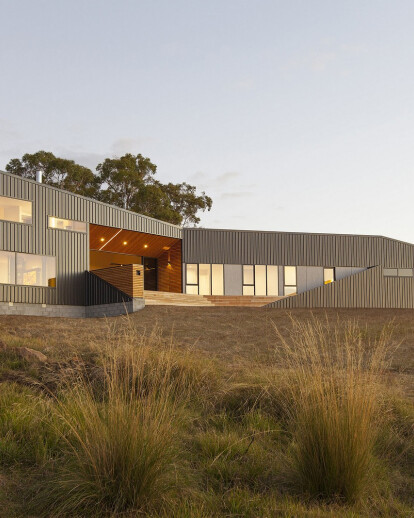The Valley House is shaped and adapted to the contours of a northwest-facing valley. Viewing down to the nearby city and river beyond, the house is centred on this valley outlook. Formed as a singular continuous object rising to the valley edge, the principal design strategy is focused on the kitchen where a generous opening is made through the full depth of the building. The suggestion is that the valley remains continuous through the house with outdoor living areas on either side accommodating variable weather conditions. Parts of the building are pulled away forming protective wings and reveal the inhabitation of the home. Tasmania timbers are a particular focus in the thresholds between inside and outside, while the textural qualities of materials are further celebrated in the interior. In crafting a comfortable and personal family home, the scheme seeks to blend the complexities and subtleties of functional requirements with specific site and microclimatic conditions in a cohesive and consistent manner.
Conceived as a singular form, the building is shaped to meet the valley edge at a lower point and then stretched with the site contour, rising in height to the north and east. The building suggestively lifts up to the northern low angle winter sun through the trees. The dark façade has elements pulled away to make shielding wings, with the exposed parts visually light, a conceptual connection to permitting the sun to penetrate the building. Covered outdoor areas are created where space is subtracted from the dark form, with timber conveying a tactile and natural warmth where users transition from inside to outside. The house is bent around the valley following the contour in the most elevated part of the site, optimising the focus of the living areas down the valley where a single generous opening is made in the building. Centred on the kitchen, decks on each side of the space serve the interior while operable glass openings mediate the unpredictable microclimatic conditions.
Externally, profiled metal cladding, cement sheet and timber reinforce a subtle link to the country shed typology in the rural context, yet elevate the modest material selections in their appropriation to residential architecture. The metal sheeting’s striation unifies the built form. The roof is articulated to respond to transitions in direction and height of the main building, becoming a significant 5th elevation viewed from the road above, while the eastern protective wing wall screens the neigbouring house above. The buildings structural frame is plantation timber while locally sourced feature timbers are used selectively. The feature-graded selection ensures variations are celebrated and where possible timbers are uncoated. The Tasmanian celery top pine and blackwood timber is locally sourced and milled.
Cost management is assisted by the strategic bending of the building in half functionally at the main entry. Effectively more of the budget is allocated to the living areas while the more utilitarian areas are less highly specified. The shallow plan depth and siting with the contours assist with managing site works. Photovoltaic power generation is designed to suit the usage of the inhabitants with managed export to the power grid. Efficient heat pump technology contributes to hot water heating with a centrally located storage unit and LED lighting fixtures are installed throughout. The building has a thermally controlled indoor area of 179sqm while appropriate solar orientation, a form that maximises natural lighting and ventilation, limited southern openings, and double-glazing contribute to a well performing envelope in the cool temperate climate zone.





























